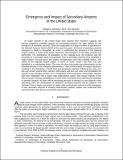Emergence and Impact of Secondary Airports in the United States
Author(s)
Bonnefoy, Philippe; Hansman, R. John
DownloadATIO_P_Bonnefoy.pdf (439.2Kb)
Metadata
Show full item recordAbstract
As major airports in the United States have reached their maximum capacity and became congested, available capacity at surrounding airports has been utilized by the emergence of secondary airports. Given the expectation of a larger number of operations in
the National Airspace System (NAS) in the upcoming years, this trend of secondary airports emergence is likely to strengthen. In order to understand the dynamics of the regional airport systems, a study of the factors that led to the emergence of secondary airports was performed. The distribution of population at the regional level, the existence and the proximity of a secondary basin of population close to secondary airports were identified as
major factors. Ground access and airport infrastructure were also enabling factors. The nature of the regional airport system, in terms of “Hub” versus “non-Hub” was also
identified as a contributing factor. The entry of a low cost carrier was determined to be the essential stimulus in the emergence phenomenon. These entries modify the airport dynamics resulting in the stimulation of both local and peripheral markets. Following the entry of a low cost carrier several other carriers, both legacy and low cost, enter and consolidate the growth of the emerging airport. As a consequence of the emergence of secondary airports and their integration into a region wide multi-airport system, they induce impacts on the NAS structure. Recent consolidations of TRACONs (Terminal Area Control) were identified as primary impacts. As there will be increasing pressure of demand on core airports in the upcoming years, the development of additional secondary airports will be required. The
transition from a single core airport to region wide multi-airport systems and the emergence of new secondary airports in existing multi-airport systems, impose new constraints that need to be taken into account in the NAS improvements.
Date issued
2004Citation
4th AIAA ATIO Forum, Chicago, Il. 2004
Keywords
secondary airports, Air traffic managemant, air transportation